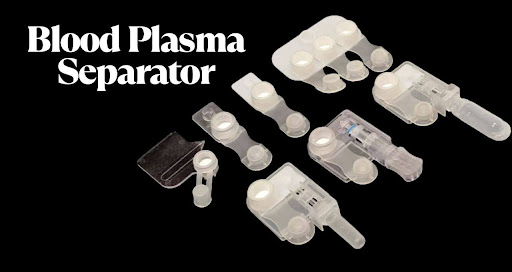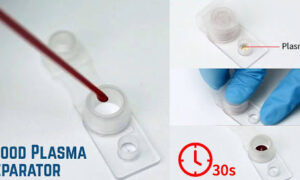In today’s rapidly changing era of disease diagnosis and treatment, the blood plasma separator is the nucleus of accuracy and patient care. It is an advanced medical machine used for the separation of plasma from whole blood to be used in the performance of various laboratory tests and treatment procedures. Through efficient separation of plasma, it presents medical practitioners with pure samples to handle, thus guaranteeing accurate diagnosis and treatment procedures.
Plasma, comprising more than 50% of blood, carries vital proteins, hormones, and nutrients. Plasma separation is paramount in numerous applications, ranging from transfusions to disease testing and medication tracking. With growing demand for accuracy within the health industry, the blood plasma separator has become an indispensable device within clinics and laboratories globally.
The Technology Behind Blood Plasma Separation
Higher-end plasma separators take advantage of the top centrifugal and membrane filtration technology to provide immediate and accurate results. Centrifugal force is used to differentiate heavier red blood cells from lighter plasma by centrifuging them off. Filters may be utilized to clean further without contamination and providing the top quality plasma for additional treatment or processing.
The device has been engineered so that it can treat both high-volume healthcare centers and point-of-care centers. As part of a daily routine for diagnostics or therapeutic procedures in particular, efficiency in a blood plasma separator is designed so that it can be processed faster and more efficiently. It is one such technological innovation which is an integral component that adds enhancement to improvement in the overall efficiency of modern healthcare systems.
Medical Applications of a Blood Plasma Separator
Blood plasma separators have one of their most significant applications in preparing plasma for injection into patients with clotting disorder, burns, or immunodeficiency. Plasma harbors necessary clotting factors and antibodies that are needed for the treatment of such diseases. Preservation of these products without any loss in function is ensured by the use of higher-quality separators.
Other than this, the blood plasma separator is also used intensively in diagnosis, especially in infectious diseases such as hepatitis and HIV. Plasma separation allows for laboratory testing to be effectively carried out on pathogens, hence resulting in early diagnosis and enhanced patient care. The device is also used in therapeutic plasma exchange to treat autoimmune diseases as well as some neurological diseases.
Benefits of Using a Blood Plasma Separator in the Laboratory
The use of automated blood plasma separators also increased the efficiency of laboratory procedures to a large extent. They reduce the chances of human error, reduce their rate of sample processing, and involve very little manual intervention. It is particularly helpful in high-throughput labs where many samples need to be processed daily.
Additionally, by keeping plasma samples clean and consistent, blood plasma separator avoids research and clinical results from contamination. Again, blood plasma separator saves money in operations in the long term since there is minimal retesting and greater precision. It is thus a value-for-money healthcare device for clinical labs concerned with quality and performance.
Impact on Patient Care and Safety
The application of an efficient plasma separator enhances patient safety and diagnostic precision. Correct plasma separation provides better disease control, drug monitoring, and individualized treatment plans. Since more precise diagnoses are offered to the patients, it reduces complications or redundant therapy.
Also, the blood plasma separator minimizes the chances of cross-reactivity and contamination that are common because of uncontrolled samples. What this means is that medical practitioners can trust the information they are working with, making them provide improved patient satisfaction and confidence. With medicine progressing even more towards personalized therapy, devices such as this are even more important.
Innovations and Future of Blood Plasma Separation
The latest technological developments have led to the creation of simpler and more transportable machines that can be used in remote or resource-constrained regions. The new plasma separators are accompanied by real-time monitoring and digital interfaces, and also with integration into other diagnostic equipment and electronic health records.
The destiny of the plasma separator also involves applying artificial intelligence to forecast sample quality and correlate processing parameters. With data-driven medicine in the future, one of the drivers that will make diagnosis and treatment regimens stand out is delivering continuous and timely plasma separation. Ongoing innovation guarantees that equipment of this nature stays current with the medical requirements of the times.
Selection of the Optimal Blood Plasma Separator for Your Practice
Plasma separator selection will be based on volume of samples to be processed, level of automation needed, and final clinical application. The facility needs to think about what they are doing now and choose an instrument that will automate and accelerate without sacrificing quality. Separators can be provided for high-throughput labs or at bedside.
Investment in a quality plasma separator is well worth the long-term gains such as reproducible results, minimum labor, and greater ease of integration into laboratory information systems. A quality selection can make a wonderful difference in quality of care and operational efficiency for any health care facility. Mention of quality manufacturers and checking product specification are the secrets of a good selection.
Regulatory Compliance and Quality Standards
Any such health device, particularly sample processing device, will need to be regulated firmly in the matter of patient safety and data accuracy. A very good separator of blood plasma would be FDA, CE, and ISO certified, and it is due to this feature that doctors are certain about using it. Product certification as proof of quality reflects a quality product.
These devices have to be trained, calibrated, and maintained regularly to operate. Adherence to standards and conformance to the company’s guidelines ensure longevity and effectiveness. It is a guarantee of patient safety and clinical excellence.
Why Blood Plasma Separators Are Indispensable Today
With focus on rapid diagnosis, patient safety, and patient care in the modern healthcare environment, technology such as the blood plasma separator is more critical than ever. Their capacity to provide clean, consistent plasma samples within minutes improves results as much as it improves workflow. It also places laboratories and clinicians in the hands of the tools for even more accurate care.
Since more research on diseases is being done and diagnostic standards are becoming specialized, the application of plasma separation cannot be emphasized enough. With advancements on a day-to-day basis, these machines are becoming cost-effective, intelligent, and an integral element of contemporary medicine. Their value to healthcare infrastructure is humungous and increasing day by day.
Looking Ahead in Medical Diagnostics
Increased dependence on lab testing and personalized medicine puts the focus on accurate sample processing equipment. With an increase in worldwide health concerns and rising worldwide pressure for effective delivery of medical treatment, equipment such as the blood plasma separator are pillars of support for medicines of the future. They are the heartbeat of all laboratories because they are so consistent and useful.
Clinics, research facilities, and labs who place their bets on the most innovative plasma separation technology are poised to fulfill the evolving needs of contemporary patient care. With the new technologies, they will be capable of providing higher accuracy, reduced turnaround time, and enhanced patient outcomes—positioning them as healthcare innovators.































